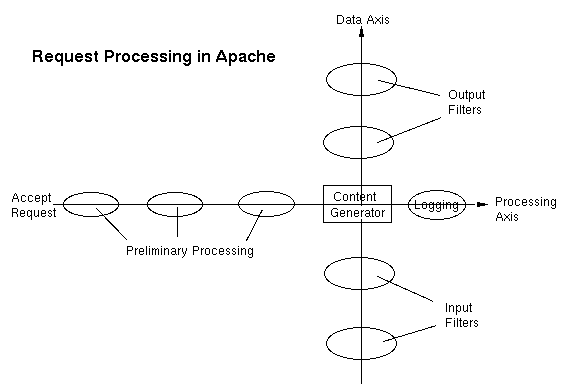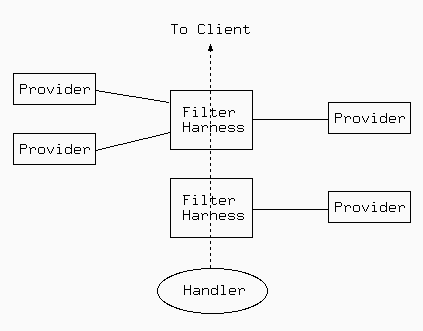Apache HTTP Server Version 2.4

Apache HTTP Server Version 2.4

This document describes the use of filters in Apache.
| Related Modules | Related Directives |
|---|---|
The Filter Chain is available in Apache 2.0 and higher, and enables applications to process incoming and outgoing data in a highly flexible and configurable manner, regardless of where the data comes from. We can pre-process incoming data, and post-process outgoing data, at will. This is basically independent of the traditional request processing phases.

Some examples of filtering in the standard Apache distribution are:
mod_include, implements server-side includes.mod_ssl, implements SSL encryption (https).mod_deflate, implements compression/decompression on the fly.mod_charset_lite, transcodes between different character sets.mod_ext_filter, runs an external program as a filter.Apache also uses a number of filters internally to perform functions like chunking and byte-range handling.
A wider range of applications are implemented by third-party filter modules available from modules.apache.org and elsewhere. A few of these are:

mod_filter, included in Apache 2.1 and later,
enables the filter chain to be configured dynamically at run time.
So for example you can set up a proxy to rewrite
HTML with an HTML filter and JPEG images with a completely
separate filter, despite the proxy having no prior information
about what the origin server will send. This works by using a
filter harness, that dispatches to different providers according
to the actual contents at runtime. Any filter may be either
inserted directly in the chain and run unconditionally, or
used as a provider and inserted dynamically. For example,
Filters can be used to process content originating from the client in
addition to processing content originating on the server using the
mod_reflector module.
mod_reflector accepts POST requests from clients, and reflects
the content request body received within the POST request back in the response,
passing through the output filter stack on the way back to the client.
This technique can be used as an alternative to a web service running within
an application server stack, where an output filter provides the transformation
required on the request body. For example, the mod_deflate
module might be used to provide a general compression service, or an image
transformation filter might be turned into an image transformation service.
There are two ways to use filtering: Simple and Dynamic. In general, you should use one or the other; mixing them can have unexpected consequences (although simple Input filtering can be mixed freely with either simple or dynamic Output filtering).
The Simple Way is the only way to configure input filters, and is
sufficient for output filters where you need a static filter chain.
Relevant directives are
SetInputFilter,
SetOutputFilter,
AddInputFilter,
AddOutputFilter,
RemoveInputFilter, and
RemoveOutputFilter.
The Dynamic Way enables both static and flexible, dynamic configuration
of output filters, as discussed in the mod_filter page.
Relevant directives are
FilterChain,
FilterDeclare, and
FilterProvider.
One further directive AddOutputFilterByType is still supported,
but deprecated. Use dynamic configuration instead.